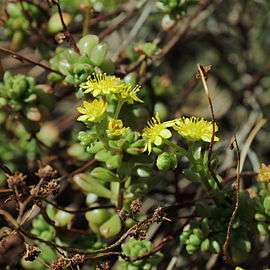Aeonium sedifolium
| Aeonium sedifolium | |
|---|---|
| | |
| Aeonium sedifolium | |
| Scientific classification | |
| Kingdom: | Plantae |
| (unranked): | Angiosperms |
| (unranked): | Eudicots |
| (unranked): | Core eudicots |
| Order: | Saxifragales |
| Family: | Crassulaceae |
| Genus: | Aeonium |
| Species: | A. sedifolium |
| Binomial name | |
| Aeonium sedifolium (Webb ex Bolle) Pit. & Proust | |
Aeonium sedifolium is a perennial plant of the family of succulents (Crassulaceae). The plant is native to the western Canary Islands.
Description
Aeonium sedifolium is a perennial, herbaceous plant or small shrub with branched stems. The flower rosettes are small compared to most aeoniums, and consist of thick and fleshy oval shaped or a trowel shaped leaves. The young leaves look similar to the leaves of Sedum genus. The leaves are sticky and are initially green, but soon form red stripes on them.
Its inflorescence is a little bundle of small, golden yellow flowers.
The plant blooms from April to May.

Naming and etymology
To botanical name Aeonium comes from the ancient Greek word "aionios" (eternal), because it retains its leaves. The sedifolium name results from the name of its sibling genus Sedum (stonecrop) and from the Latin word folius (leaves), because of the similarity with that species.
Habitat and distribution
Aeonium sedifolium grows in full sun or partial shade on eroded volcanic soil. The plant is native to western Tenerife in the Canary Islands, the islands of La Palma and La Gomera.